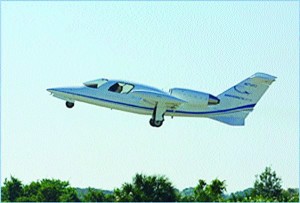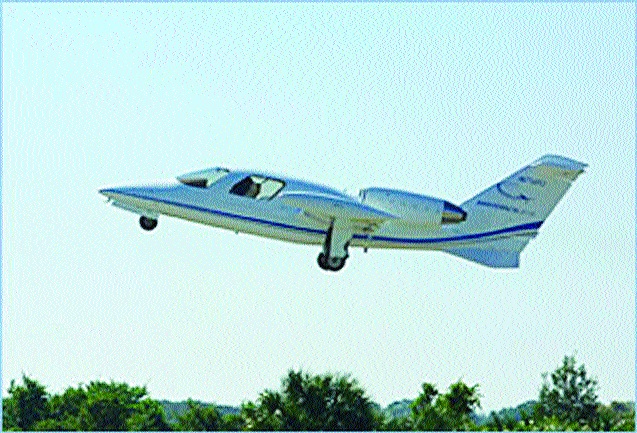By S. Clayton Moore

Pilot Jack Reed was the chief test pilot for the Maverick “Leader” series of experimental jets. His fatal crash leaves the company with both a personal and professional loss, but company executives vow to move forward.
Despite the tragic death of their chief test pilot, retired Air Force aviator Jack Reed, in a January 24 crash, the leaders of Florida-based Maverick Jets are doing their best to honor his memory by moving forward with their company plans.
Reed was killed when the Maverick “Leader” twinjet he was flying, registered as N750TJ, crashed at Melbourne International Airport in Florida. The five-seat experimental kit plane, powered by a pair of 750-pound-thrust GE T58 engines, impacted a quarter of a mile northwest of the arrival end of runway 9L, following several flights around the area. Just following Reed’s 4:50 p.m. takeoff, he radioed that he had a problem with the landing gear and did several flights past the tower.
Michael Lewis, spokesman for Aero Group, Inc., a tactical fighter company based at the airport, witnessed Reed’s flight while he was videotaping for another project.
“We were out there that day,” remembered Lewis, who was good friends with the late pilot. “We had just landed one of our A-4s and we saw the aircraft circle about three times, and then we lost sight of it behind the hangars.
There were some reports that the gear was not coming down on the aircraft and someone said that Reed had declared an emergency over the radio.”
“Behind the tree line, we caught a glimpse of the smoke (from the crash),” Lewis continued. “We didn’t actually witness the impact but we did see him flying right before. That was the last time we saw him.”
Operations at Melbourne International were unaffected by the incident due to its distance from high-traffic areas, according to Eden Cook, public relations manager for the airport.
“It was far enough from the runways that we didn’t have to close them or divert flights,” Cook said following the incident.
According to the National Transportation Safety Board’s preliminary report, Reed was going to attempt a belly landing on the grass between runways but apparently lost control and crashed into the trees. The Melbourne Fire Department’s airport station responded to the scene at 4:59 p.m., and quickly extinguished the fire that erupted around the site. The incident was the first air fatality in Melbourne in more than 20 years.
Lewis said that Reed was a skilled pilot with a great personality and sense of humor.
“He really knew how to keep things gelled together,” Lewis remarked. “In aviation, situations sometimes get a little bit stressful; every time I saw Jack in any of those kinds of situations, he was always making sense of it, calming the situation and keeping people productive.”
Maverick Jets, which prides itself as a leader in the lightweight personal executive jet industry, is currently producing five to 15 of the twinjets per month. The aircraft retails for approximately $750,000 and is powered by T-58 military engines that have been used in heavy lift helicopters for the U.S. Marine Corps.
It has a maximum cruising speed of 350 knots and a maximum altitude of around 31,000 feet. The jet manufacturer counts aviation legend Bob Hoover among its clients and recently signed him on as an official spokesman.
Maverick’s president, Jim McCotter, has also said he is developing a six-seat production derivative of the Leader powered by engines in the 1,000 to 1,300 pound thrust range.
Prior to the crash, the jet has also had an excellent safety record. The aircraft Reed was flying received its airworthiness certificate in December 1999, according to FAA records, and held valid registration. As recently as the AOPA Expo, held in October 2002, Reed stated that the jet had received numerous changes to the wing and landing gear placement, improving its safety further.
Sandy Scott, Maverick’s director of client development, said the company has no plans to scale back operations in wake of the crash and has seen no reduction in interest from clients.
“The company has more resolve than ever,” Scott said. “As a matter of fact, we just put three around-the-clock crews on an airplane we’re building here in the factory. The boss just flew out to Oregon this weekend to buy an airplane so one of our customers will have a demo jet available. The company is in great shape. We have 15 people waiting for demos and in fact, the Monday after the accident, we got orders for six aircraft from customers who were all well aware of what had happened.”
“Jack Reed was the most popular employee we had,” Scott said of Reed, who held the office of vice president of flight operations. “We just want to do what he would want. It’s a great product and a great company and you’ll see a lot of us.”
Lewis remembered his friend as an extraordinary pilot who was capable of some remarkable maneuvers.
“The first time I met Jack was when the folks at Maverick asked if I would shoot some video of him doing some high-speed, low-altitude passes over the Melbourne runway,” Lewis remembered. “We waited until late in the afternoon when the sun was low in the sky and Jack positioned the aircraft so that it looked like he was flying right out of the sun.”
“It was really exciting to watch him fly that thing right over us,” Lewis continued. “That was the first time I had seen his flying ability and he was just rock-solid in keeping this little jet on the straight and narrow. It was fantastic.”
Reed was a retired Air Force aviator who spent 22 years in the service and served as a jump-qualified pararescue specialist as well as gaining a diver’s badge and serving a full tour in Vietnam. He leaves behind his wife Christine and two sons, Jack and Dennis Reed.











